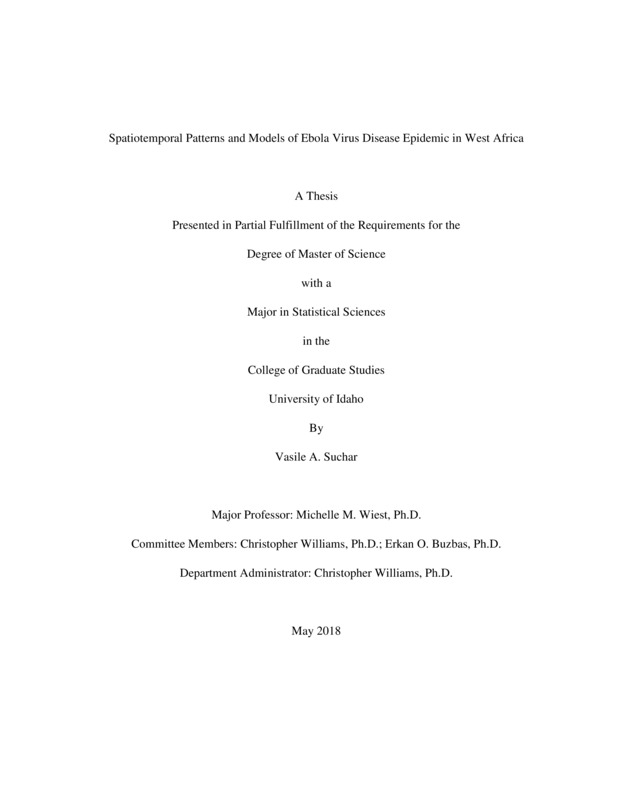Spatiotemporal Patterns and Models of Ebola Virus Disease Epidemic in West Africa
Suchar, Vasile Alexandru. (2018-05). Spatiotemporal Patterns and Models of Ebola Virus Disease Epidemic in West Africa. Theses and Dissertations Collection, University of Idaho Library Digital Collections. https://www.lib.uidaho.edu/digital/etd/items/suchar_idaho_0089n_11323.html
- Title:
- Spatiotemporal Patterns and Models of Ebola Virus Disease Epidemic in West Africa
- Author:
- Suchar, Vasile Alexandru
- Date:
- 2018-05
- Program:
- Statistical Sciences
- Subject Category:
- Statistics; Epidemiology
- Abstract:
-
The purpose of this study was to investigate the utility of exploratory analytical techniques using publically available data in informing interventions in case of outbreaks infectious diseases. More exactly, spatiotemporal and multivariate methods were used to characterize the dynamics of the Ebola Virus Disease (EVD) epidemic in West Africa, and propose plausible relationships with demographic/social risk factors. The analysis showed that there was significant spatial, temporal, and spatiotemporal dependence in the evolution of the disease. For the first part of the epidemic, the cases were highly clustered in a few administrative units, in the proximity of the point of origin of the outbreak, possibly offering the opportunity to stop the spread of the disease. Later in the epidemic, high clusters were observed, but only in Liberia and Sierra Leone. The spatial-temporal models suggested that Montserrado area was a source of new cases for the neighboring areas, while NW Sierra Leone region was a sink for new cases from the neighboring areas. Also, there were region-specific population responses to the outbreak. Social attributes effects were significant - although small – pointing towards the importance of hypothesized social attributes of the population in the outbreak dynamics. Overall, the analysis suggests that infrastructure, access to and use of health services, and connectivity possibly accelerated and magnified the spread of EVD. The spatial, temporal, and spatiotemporal patterns of epidemic can be clearly shown – with evident application in the early stages of management of epidemics. Moreover, spatial-temporal models with fairly high predictive power could have been proposed even during the peak of the EVD epidemic – given that the data were available. But these efforts were not possible due to limited access or absence of quality data. While many of these deficiencies might have been unavoidable due to the severity of the epidemic and the limited resources of both affected countries and intervening agencies, open access to quality data, integration of local knowledge and customs, and continuous monitoring at the lowest spatiotemporal resolution possible during outbreaks might be useful, save time, resources, and allow for more effective decision support tools to be created in real time in the future. There are six supplemental information (SI) files: SI 1 covers the methodology for the case counts calculations. SI 2-4 covers the local spatial autocorrelation analysis for the three distance matrices considered. SI 5 presents the prospective spatiotemporal clustering analysis, and SI6 presents the complete spatiotemporal modeling results.
- Description:
- masters, M.S., Statistical Sciences -- University of Idaho - College of Graduate Studies, 2018-05
- Major Professor:
- Wiest, Michelle M
- Committee:
- Williams, Christopher; Buzbas, Erkan O
- Defense Date:
- 2018-05
- Identifier:
- Suchar_idaho_0089N_11323
- Type:
- Text
- Format Original:
- Format:
- application/pdf
- Rights:
- In Copyright - Educational Use Permitted. For more information, please contact University of Idaho Library Special Collections and Archives Department at libspec@uidaho.edu.
- Standardized Rights:
- http://rightsstatements.org/vocab/InC-EDU/1.0/

